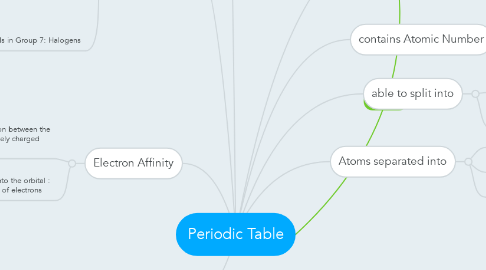
1. Ionisation Energy
1.1. Down a group
1.1.1. ionisation energy decreases
1.1.1.1. -greater number of quantum shells -greater shielding effect between the inner electrons and the valence electrons -forces of attraction between the positively charged nucleus and negatively charged electrons decrease
1.1.2. Atomic radius increases
1.2. Across a period
1.2.1. ionisation energy increases
1.2.1.1. -increasing number of protons --> -same number of quantum shells -stronger electrostatic forces between the positively charged nucleus and negatively charged electrons.
1.2.2. Atomic radius decreases
1.3. definition: energy required to remove an electron from an atom in the gas phase.
2. Elements
2.1. Metals in Group 1: Alkali metals
2.1.1. Physical Properties
2.1.1.1. soft, can be cut easily
2.1.1.2. generally low density
2.1.1.3. low melting point and m.p decreases down the group
2.1.2. Chemical Properties
2.1.2.1. down the group, reactivity increases
2.1.2.2. Tracts with water to form alkaline and hydrogen gas
2.1.2.3. readily lose single valence electron in the valence shell to form cation with 1+ charge
2.1.3. Displacement Reaction takes place when a more reaction metal displaces a less reactive metal from its compounds.
2.2. Non-metals in Group 7: Halogens
2.2.1. Physical properties
2.2.1.1. density increases down the group
2.2.1.2. melting point increases down the group
2.2.2. Chemical Properties
2.2.2.1. down the group, the reactivity decreases
2.2.3. Displacement Reaction takes place when a more reaction halogen displaces a less reactive halogen from its compounds.
3. Electron Affinity
3.1. Definition: measure of the attraction between the 'incoming' electron and the positively charged nucleus.
3.1.1. stronger the attraction, the greater the electron affinity
3.2. the electron goes into the orbital : complete attraction of electrons
3.2.1. increases across the period (?)
3.2.2. increases down the group
4. Electrognegativity
4.1. definition: the ability of an atom to pull electrons towards itself in a bond (compounds)
5. Atoms
5.1. neutrons
5.2. electrons
5.3. protons
5.4. single substance
5.4.1. a matter that which has specific composition and specific properties
5.5. loses/gains an electron
5.5.1. becomes ions
5.5.2. loses electron: cation
5.5.3. gains electron: anion
6. Atoms separated into
6.1. metals
6.2. non-metals
6.3. metalloids
7. contains Atomic Number
8. able to split into
8.1. groups
8.1.1. 8 groups
8.1.1.1. columns
8.1.2. find out about its valency
8.1.2.1. by counting the number of valence electrons
8.2. periods
8.2.1. rows
